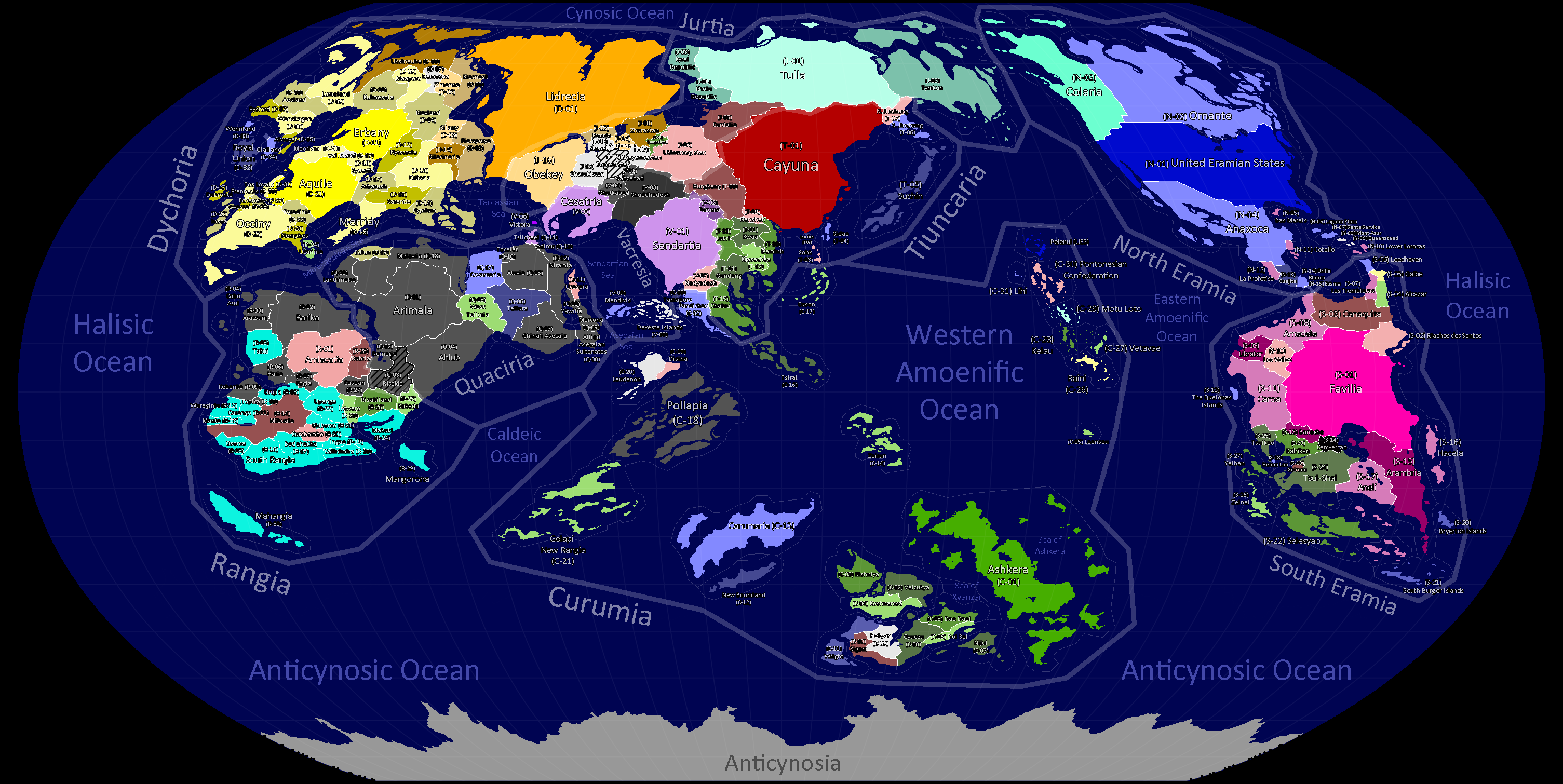Factions / Influence
[GSTA] Global Strategic Treaty Alliance
Post-Cold War NATO reunites against new challenger for global hegemony.
Originally formed to combat the Soviet Union, it is most powerful in the "Erdlo-sphere" countries, though many Dychorian countries are also members. Founded by the United Eramian States.
Following the Black Tuesday Cyberattack, which seriously damaged U.E.S. computer networks, and the subsequent shift in the public loyalties of Ashkera, it has been retooled to focus on socio-political containment of the ISU (under Cayuna), Mirograd Pact (under Lidrecia) and GX, which have become politically aligned over the past 20 years.
[GX] Greater Xyanzar Joint Economic Development & Defense Initiative
Nationalist technocrats challenge liberal democrats for global hegemony.
A group consisting mostly of bureaucratic military dictatorships, stratocratic republics, illiberal democracies, and dominant party states, operating under the leadership of the Fifth Empire of Ashkera. These regimes are pursuing an ideology of "National Development," focusing on internal stability and the sustainable intergenerational accumulation of wealth.
Some member states are a legacy of Ashkeran colonialism by the now-defunct Fourth Empire, particularly in Rangia and Southern Eramia.
GX aligned with the GSTA during the Cold War against the International Socialist Union, fighting a number of proxy wars in Southern Tiuncaria through the 1960s and 1970s. Since the Telluran War in the early 00's, GX has gradually drifted away from its cooperation with the United Eramian States, a move which proved useful when the UES withdrew from many global institutions between 2016 and 2024.
Following the Black Tuesday Cyberattack in 2028, Ashkeran leadership openly declared their opposition towards "global unification" and GX has started to contest GSTA for political influence in South Eramia, Rangia, and parts of Quaricia.
[IDG] International Development Group
Wealthy city-state guides development of the subcontinent.
One of the most recent power blocs to emerge onto the world stage, the IDG is a regional economic union and military alliance currently including Vistora, Cesatria, Tzilchael, Sendartia, and Puruma. Founded in 1991 at the outset of the Cold War, the IDG gives organized form to Vistora's considerable post-war diplomatic efforts, especially in light of the Civic Republic's prior failures to prevent the Wafaist Revolution in Cesatria, contain the Tzilchaeli-Adimu Conflict, and prevent conflict roiling from its native region of Vacresia. Guided by these imperatives and supported by the pillars of Vistoran liberalism, the IDG aims to facilitate freedom, prosperity, security at home while promoting its value abroad. Currently, the IDG is closely aligned with the GSTA and DyCon and aims to expand into Ghutkabad, Shuddadesh, Nadyadesh, the Devesta Islands, and beyond.
[NAP] North Amoenific Partnership
Alaskan Seattle develops, secures Siberia.
While it is on good terms with the neighboring United Eramian States, Colaria founded this economic partnership to ensure the proper development and security of Tulla and its partners in Northern Jurtia, as well as access to the resources of that vast and cold expanse.
[DyCon] Dychorian Confederation
Europe averts crisis through painful devolution of power, currency.
The 2016 buyout of Ucarinia by GX sent ripples through the Dychorian Union, with concerns that high debt levels on the periphery (fueled in part by the unified Dyro currency) as well as inadequate military equipment might lead to a gradual erosion of the Union in the face of the Mirograd Pact.
An uncomfortable deleveraging and reorganization followed, leading to the establishment of regional currencies and a multi-tier confederation instead, formalized in 2020. Ten years later, the situation has stabilized, but not without pain.
[ISU] International Socialist Union
Post-USSR, socialists turn to China.
The arch-enemy of the GSTA and GX from 1950 until the late 1980s, when the Soviet Union collapsed. Lidrecia left the ISU, leaving it as a vehicle for Cayuna, which was now practicing Socialism with Cayunese Characteristics.
The remaining countries needed a sponsor, and in some cases the Cayunese were willing to oblige. Tensions with GX and the GSTA declined over time.
Since the Mutual Agreement for the Economic Security of the Cayunese People in 2020, which stabilized markets in Cayuna following a significant decline in exports to the United Eramian States, the ISU has become increasingly cooperative with GX.
[MP] Mirograd Pact
Russia firms post-Cold War geopolitical position.
The end of the Cold War did not end Lidrecia's ambitions.
[SEU] South Eramian Union
South America struggles to seek own destiny.
Influence in this alliance is split between Favilia and a group of Spanish-speaking nations.
[RA] Rangian Alliance
Spark of development spreads slowly through Africa.
Emerged in the late 1980s under the leadership of South Rangia, which industrialized as the economy became more global. It has expanded gradually over the last 40 years.
History
World Map
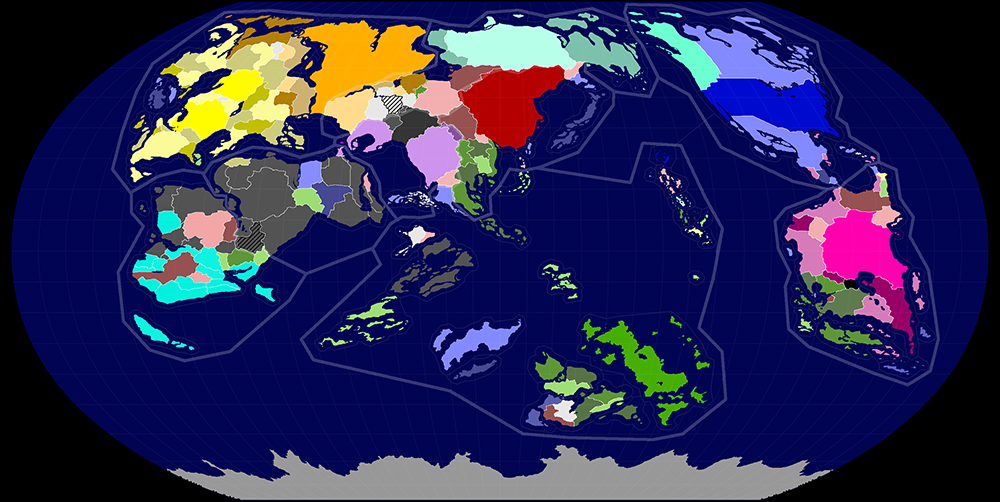
Countries by Region
Curumia (C)
Ashkera
The Fifth Empire of Ashkera, Ashkera (Ashkerron)
Centrist Nationalist Survivalist Dominant-Party Technocracy
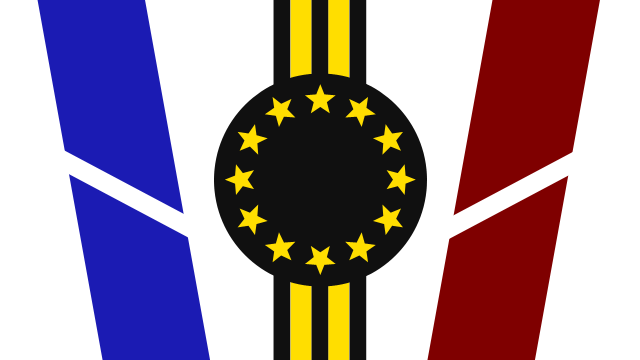 |
| Region |
Curumia |
| Capital |
Galgatta |
| Bloc |
JDI, 1943 |
| Economy |
Mixed |
| Ruler |
Central Director Muralkama |
| Government |
Dominant-Party Technocracy |
| Ruling Party |
National Technocracy Union |
| Pop |
285,242,350 |
| Area (km2) |
3,748,235 |
| Density (/km2) |
76.1 |
| GDP / Cap |
$85,448 |
| GDP (Billions) |
$24,373 |
| Title |
Fifth Empire |
| Established |
1918 |
| Origin |
2501 BCE |
| Animal |
Ashkeran Tiger |
The Fifth Empire of Ashkera is a mostly forested nation with a wide variety of climates, split between a subcontinent-sized landmass and several chains of large islands. Ruled by an enigmatic government with interests in technology, risk analysis, and environmental management, it has recently reprised its historical role as a contender to the West for global hegemony.
Ashkera is founder of the Greater Xyanzar Joint Development & Defense Initiative (GX or JDI), a group of politically-illiberal countries with an agenda of national development. Though GX sided with the Liberal Democrats during the Cold War, by 2030 many of the Western democracies see the country as a latent threat. Recent megaprojects focused on addressing climate change have raised tensions over the risks of geoengineering.
The nation has a highly-developed mixed economy backed by a substantial, but goal-oriented welfare system. The police state government mostly permits citizens to live their own lives, but watches carefully for anyone to slip up. Civil order reigns supreme and crime is well under control.
Capitalism and Socialism are considered mere tools to meet national objectives, members of rioting political groups are forced to purchase insurance against their risk of terrorism, state-owned enterprises are known to mysteriously profit from complex geopolitical disruptions, and tax accountants are rapidly being replaced with machine-learning software.
A growing underclass zip between state-subsidized microjobs on mopeds, guided by their smartphones. Organized crime has been replaced with a 'theme park' version of itself based on ritualistic dueling and feudal codes of honor, with its foreign branches subverted by the state's intelligence apparatus. Criminal organizations follow careful safety guidelines when dispensing drugs in order minimize their liability. Semi-secret police are used to fight insurance fraud, monitor compliance with environmental laws, and conduct elaborate anti-corruption sting operations. Trafficking in children or nuclear materials is punishable by public execution.
The path of the central figure of the national religion reads like a cross between a book of moral allegories and The Art of War, and followers are expected to emulate its half-devil warrior-philosopher and prepare for the final war with the heavens. It is customary to smash an idol of the God of Failure before taking the National General University Entrance Exam. Survival techniques and martial arts are taught in every school from age seven up, even though only rural children have a real risk of death by wild animal attack.
Access to tilt-rotor aircraft is considered high-status, intellectuals in other countries have sneeringly described the country as a 'futuristic dystopia' since 1972, and Oversight Councillor One has replaced the Illuminati in the imaginations of conspiracy theorists the world over.
Vacresia (V)
Vistora
Civic Republic of Vistora, Mardōmkār-ē Shahri-yē Vezh-Tohrā
Global Financial Hub & Dense Maritime Trading City-State
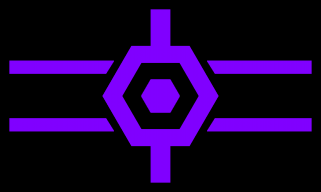 |
| Region |
Vacresia |
| Capital |
Sector Zero |
| Bloc |
IDG, ca. 1994 |
| Economy |
Developed Free Market |
| Leader |
Eskandriyā “Eski” Isfarād |
| Government |
Lib-Tech Republic |
| Ruling Party |
New Civic Alliance |
| Pop |
48,172,108 |
| Area (km2) |
7,159 |
| Density (/km2) |
6,729 |
| GDP / Cap |
$81,906 |
| GDP / Cap (PPP) |
$121,906 |
| GDP (Billions) |
$3,945 |
| GDP (Billions, PPP) |
|
| Title |
Civic Republic |
| Established |
1934 |
| Animal |
Vistoran Raven |
Often referred to as the “Gateway to the World” in times both ancient and modern, Vistora is an island-bound city-state positioned at the convergence point of the Old World’s most important maritime trade routes, enabling the diminutive isle to act as an international hub for trading and commerce since antiquity.
Though its current administration was formally established in 1934 following its departure from Caradish suzerainty, Vistora as a civilization is considered to be the heir to a contiguous civic tradition stretching back no less than 2700 years, when fugitive Pasdian slaves formed a colony on the island and established one of the world’s first and oldest republics, then and ever since known as Vistora. Even as great empires rose and fell all around it, for all but a few brief spells Vistora retained its core independence and distinctive identity all throughout time.
In modern times, Vistora has become one of the world’s largest and most prosperous cities, not only in its historical role as a global trade entrepôt and transportation hub, but also a worldwide leader in technology, finance, and other advanced knowledge/service-economy sectors, as well as high-value manufacturing. It often tops global charts of GDP per capita, human development, economic freedom, public service quality, and clean governance, although conversely it struggles with income inequality and job security.
As a country long famed for its wealth and located at the crossroads of so many historical civilizations, Vistora has seen a vast diversity of peoples arrive throughout time in search of the freedom and fortune it offered. As a result, Vistora is one of the most ethnically and culturally diverse countries in the world, featuring a great many large diasporic communities in addition to its “native” Cesatrianate population. Nevertheless, its native culture and historical religion of Mahanism provide a rich substrate that nevertheless remains prominent in Vistoran society to this day.
Vistora’s political structure is moreover rather unique in spite of its faithful adherence to republican custom. Today identified as a sort of “Liberal-Technocracy”, its two prime constituents date back to the time of its founding; a single Shahrthār (variously translated as “Mayor” or “Chief Executive”) typically elected by the citizen body to act as the individual head of state and government, and a Parishād (“Council”) of circularly self-appointed technocratic legislators.
Vistora is also a popular tourist destination. Its “Old City” of well-preserved historical buildings from major civilizations dating back to classical antiquity is considered a treasure trove for archaeologists, anthropologists, historians, and sightseers alike. Meanwhile, its vastly populous central sectors are famous for its numerous modern attractions—Vistora is host to the Hyperspeed International motorsport league’s Championship Finals—crowned with a skyscraper-studded skyline containing Moonlight Plaza, the tallest tower in the world a 1600 meters, followed by no less than the third, fifth, seventh, and eighth tallest after it.
Jurtia (J)
Sunqaristan
The Republic of Sunqaristan, Sunqar
Corrupt, Empty & Whimsical Dictatorship Ruled from Arcology
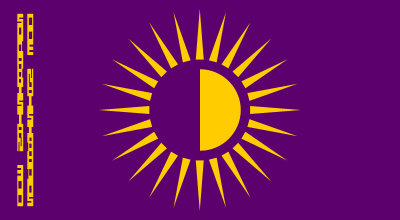 |
| Region |
Jurtia |
| Capital |
Ulken Qala |
| Bloc |
JDI, 1962 |
| Economy |
State Capitalist |
| Ruler |
President Kalya Qarsiga |
| Government |
Whimsical Despotism |
| Ruling Party |
Sunqari Futurist Party |
| Pop |
399,098 |
| Area (km2) |
37,651 |
| Density (/km2) |
10.6 |
| GDP / Cap |
$12,804 |
| GDP (Billions) |
$5.11 |
| Title |
Republic |
| Established |
1962 |
| Animal |
Ozena Falcon |
The Republic of Sunqaristan is a small, relatively barren country surrounded by mountains. Its primary exports are quinoa, alpaca fleece, and heavy metals which feed the Ashkeran nuclear industry.
The ruling Sunqari Futurist Party came power during the Cold War, funded, armed, and supplied with propaganda materials by the Fifth Empire of Ashkera, which had an interest in the country due to its large deposits of thorium and uranium, and close proximity to the Soviet Union. That it triumphed over the Communist Sunqari Peoples Revolutionary Army while right next to the USSR is generally considered either quite remarkable or a victory for Ashkeran air power, depending on who one asks.
Since then, the country has been effectively ruled as a hereditary monarchy by the Qarsiga family. Economic activity is dominated by the mining industry in the north, the JDI military base not far from the capital, and the Tas Sarayi (1971) and Jer Sarayi (2016) arcologies in the capital, each a futurist experiment funded by the JDI and intended to push Sunqaristan into a new era of economic development. The arcologies have mostly failed in this goal, and instead house the wealthiest and most connected members of Sunqari society.
The current ruler is a vain 42-year-old woman with children by three men and seven surrogates, most known internationally for her attempts to connect with modern pop culture via the Internet and hiring aging celebrities from more developed countries. By dictator standards she is otherwise largely harmless.
Quaricia (Q)
West Telluria
The Republic of Western Telluria, at-Tilūriyyah al-Ḡarbiyyah
Nascent Stratocratic Republic Undergoing Emergence of New Collective Identity
 |
| Region |
Quaricia |
| Capital |
Jabal 'Abyad |
| Bloc |
JDI, 2025 |
| Economy |
Mixed |
| Ruler |
President M. Bukhari |
| Government |
Stratocratic Republic |
| Ruling Party |
New Dawn Party |
| Pop |
48,970,017 |
| Area (km2) |
555,216 |
| Density (/km2) |
88.2 |
| GDP / Cap |
$14,405 |
| GDP (Billions) |
$705 |
| Title |
Republic |
| Established |
2025 |
| Animal |
Eagle |
In 2006, most Republican voters in the United States considered Ashkera's then-NTU Chairman Augul Tzulan's "three step plan" for "national genesis in Tellura within one generation" to be both an act of hubris and an act of betrayal.
The Ashkerans didn't agree, and after Ashkera's involvement in the 2003 Telluran War sunk the ruling National Technocracy Union's approval numbers to multi-decade lows, Mr. Haoi's announcement saw poll numbers begin to recover. In 2009, the Obama administration agreed to a partitioning of responsibilities in Tellura as a means to draw down American troop commitments. The area under JDI control became known as the West Telluran Military Control Zone.
The Joint Defense Initiative rewrote every textbook in the control zone, trained thousands of new teachers and new personnel, imposed discipline towards a new order on hundreds of cultural issues (from requiring new sanitation rules in food preparation to banning cousin marriage), and built new infrastructure, violently putting down resistance. Tellura had skewed young, and for the new generation, partially culturally divorced from their parents due to speaking Erdlish, "Western Telluria" is all they've ever known. Older children watched the transformation first-hand, while for younger children, many now in their early 20s, the wave of development occurred just before they arrived at their life milestones.
In January of 2025, military leaders in West Telluria, with the approval of the newly-elected President, declared formal independence from Tellura and the formation of a new Republic. The original Republic of Tellura wasn't really in a position to stop them. On December 3rd, 2025, the new country was admitted into the Joint Defense Initiative.
A period of mandatory military or civil service is required to obtain full citizenship and the right to vote, and Ashkeran colonial government personnel were slowly phased out as new West Tellurian citizens completed their training and experience in government positions.
The re-emergence of the Wafa'ist State of Tellura and Niramia in 2010 proved to be the uniting challenge for the older members of the new generation, as the newly-drafted West Telluran troops were trained by JDI personnel and issued older JDI equipment to go and fight WSTN in Tellura. Showing greater discipline than neighboring armies, they managed to largely push WSTN out of Tellura by 2013, though periodic terrorist attacks continued throughout the country.
The seat of economic and political power is the planned city of Jabal Abyad, constructed along the coast to serve as the new capital and as a regional hub for petrochemical refining (vertical integration) specializing in plastics and other materials. A nuclear-powered desalination plant, one of the largest in the world, has been built along the coast.
Tellura
The Republic of Tellura, at-Tilūra
Corrupt Post-War Republic
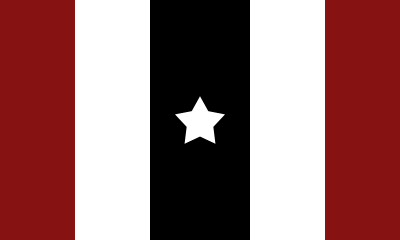 |
| Region |
Quaricia |
| Capital |
Wasata Almadina |
| Bloc |
NEATO, 2012 |
| Economy |
Mixed |
| Ruler |
President K. Abdi |
| Government |
Federal Parliamentary Republic |
| Ruling Party |
Tellura National Federal Party |
| Pop |
70,885,324 |
| Area (km2) |
795,570 |
| Density (/km2) |
89.1 |
| GDP / Cap |
$10,295 |
| GDP (Billions) |
$730 |
| Title |
Republic |
| Established |
2009 |
| Animal |
Falcon |
Though some progress has been made, nearly three decades after America launched the Telluran War, the Republic of Tellura remains one of the most corrupt countries in the world on several international rankings. The country was split by occupying forces in 2009, with the western portion falling under the control of Ashkera and the Joint Defense Initiative, while the core and eastern portions fell under an increasingly sparse coalition of American and NEATO forces. Periodic outbursts of sectarian violence continued well into 2022.
The Wafa'ist State of Tellura and Niramia re-emerged in the conflict-torn country in early 2010, coming over the border from Niramia and drawing fighters from all over the world. Republic forces had significant difficulty repelling them, and they temporarily seized the capital in early 2012, threatening to cause a total governmental collapse. JDI-backed forces from West Telluria pushed WSTN out of the bulk of the country by late 2012, and eventually out of Tellura entirely by early 2013.
West Telluria declared independence in 2025. Though there has been some talk of reunification, it is considered less likely with each passing year as the countries diverge farther governmentally and culturally.
